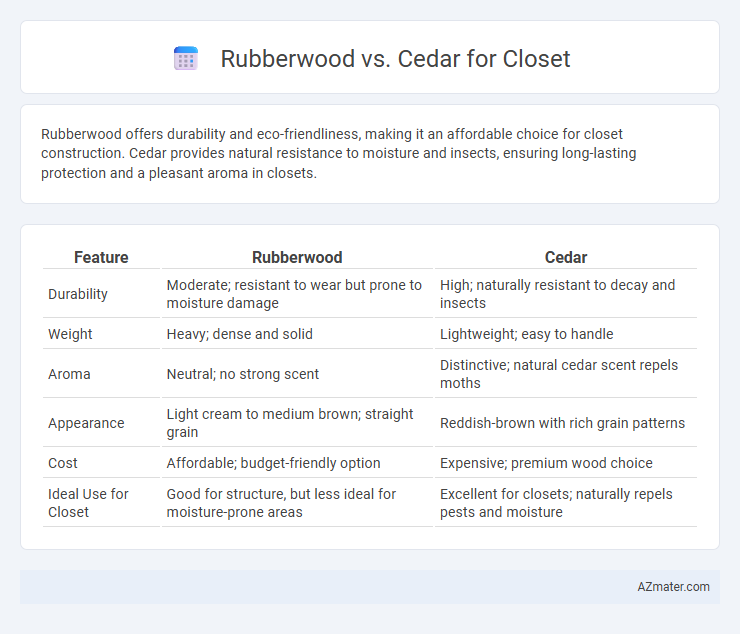Rubberwood offers durability and eco-friendliness, making it an affordable choice for closet construction. Cedar provides natural resistance to moisture and insects, ensuring long-lasting protection and a pleasant aroma in closets.
Table of Comparison
| Feature | Rubberwood | Cedar |
|---|---|---|
| Durability | Moderate; resistant to wear but prone to moisture damage | High; naturally resistant to decay and insects |
| Weight | Heavy; dense and solid | Lightweight; easy to handle |
| Aroma | Neutral; no strong scent | Distinctive; natural cedar scent repels moths |
| Appearance | Light cream to medium brown; straight grain | Reddish-brown with rich grain patterns |
| Cost | Affordable; budget-friendly option | Expensive; premium wood choice |
| Ideal Use for Closet | Good for structure, but less ideal for moisture-prone areas | Excellent for closets; naturally repels pests and moisture |
Introduction to Rubberwood and Cedar for Closets
Rubberwood, derived from the Para rubber tree, is prized for its durability, eco-friendliness, and smooth grain, making it a popular choice for closet construction. Cedar is renowned for its natural aromatic properties, insect-repellent qualities, and resistance to moisture, ideal for preserving clothing in closets. Both woods offer distinct advantages in longevity and functionality, influencing their suitability for various closet designs.
Material Origins: Rubberwood vs Cedar
Rubberwood originates from the Para rubber tree (Hevea brasiliensis), primarily grown in Southeast Asia, and is a sustainable byproduct of latex production. Cedar, typically from the genus Cedrus or closely related species like Western Red Cedar (Thuja plicata), is native to the mountainous regions of the Himalayas or the Pacific Northwest, respectively. The natural oils in cedar provide insect resistance and a distinctive aroma, while rubberwood is prized for its eco-friendly, durable hardwood characteristics ideal for closet construction.
Appearance and Aesthetic Qualities
Rubberwood features a light, creamy color with subtle grain patterns that provide a clean, modern appearance ideal for bright, minimalist closet designs. Cedar offers rich reddish-brown hues with distinctive aromatic qualities and pronounced grain, adding warmth and a rustic, natural charm to closet interiors. The choice between these woods impacts the aesthetic tone, with rubberwood presenting a sleek look and cedar bringing a cozy, textured feel.
Durability and Longevity Comparison
Rubberwood offers moderate durability with resistance to warping and cracking, making it suitable for budget-friendly closet construction. Cedar provides superior longevity due to its natural oils that repel insects and resist moisture, enhancing its durability in humid environments. Choosing cedar closets ensures extended lifespan and minimal maintenance, whereas rubberwood requires protective finishes to achieve comparable durability.
Resistance to Insects and Mold
Rubberwood offers moderate resistance to insects and mold due to its dense grain and natural oils, but it may require treatment to enhance durability in humid closet environments. Cedar excels in repelling insects and resists mold growth naturally, thanks to its aromatic oils, making it a superior choice for closets prone to moisture and pest issues. Choosing cedar ensures long-lasting protection and reduces the need for chemical treatments in maintaining closet hygiene.
Maintenance and Care Requirements
Rubberwood closets require moderate maintenance, needing regular dusting and occasional polishing to prevent drying and cracks, while their resistance to pests reduces the need for chemical treatments. Cedar closets naturally repel moths and insects due to their aromatic oils, but require periodic sanding and re-oiling to maintain their protective scent and prevent drying out. Both materials benefit from avoiding excessive moisture and maintaining stable indoor humidity to prolong the lifespan of the closet.
Sustainability and Environmental Impact
Rubberwood is a highly sustainable choice for closets because it repurposes the byproducts of the latex industry, reducing waste and promoting responsible forestry. Cedar, while naturally resistant to pests and mold, is often harvested from slower-growing trees, leading to concerns about deforestation and habitat loss if not sourced sustainably. Choosing FSC-certified Rubberwood or Cedar ensures minimal environmental impact by supporting responsible forest management and reducing carbon footprints associated with timber production.
Cost Differences: Rubberwood vs Cedar
Rubberwood is generally more cost-effective than cedar for closet construction, offering a budget-friendly option without sacrificing durability. Cedar, being a premium hardwood, commands a higher price due to its natural resistance to moisture, insects, and its aromatic properties that help repel moths in closets. Comparing prices, rubberwood typically costs 30-50% less than cedar, making it a popular choice for cost-conscious homeowners seeking a balance between affordability and quality.
Odor and Natural Properties
Rubberwood offers a neutral, mild scent that is less likely to interfere with clothing odors, making it ideal for closet environments. Cedar naturally emits a strong, pleasant aroma rich in natural oils like thujone, which acts as a moth repellent and humidity regulator. While cedar's fragrance enhances closet freshness, rubberwood's hypoallergenic and odor-neutral properties cater to sensitive users seeking subtlety.
Best Choice: Which Wood is Right for Your Closet?
Rubberwood offers durability, affordability, and a light, uniform grain ideal for modern closet designs, while cedar provides natural resistance to moisture and insects with a rich aroma that helps protect stored clothes. Choosing between rubberwood and cedar depends on prioritizing budget and smooth finishes versus natural protection and scent. For a closet emphasizing long-term garment care and pest resistance, cedar is superior; for cost-effective, sleek aesthetics, rubberwood is the best choice.

Infographic: Rubberwood vs Cedar for Closet
 azmater.com
azmater.com